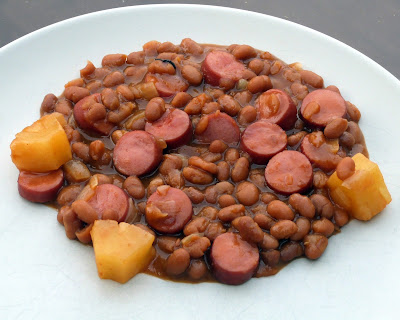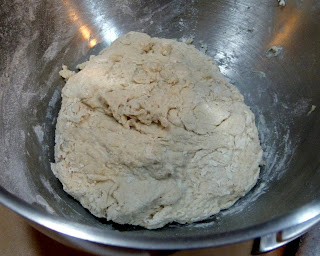Today's post is inspired by two recipes I found in Peimei's Chinese Cookbook. The first recipe, the shredded pork, is transliterated jingjiang rousi. This is a classic northern Chinese dish, and as such was sort of outside my normal milieu when it comes to Chinese cooking. Peimei serves it with dan bing, the same super-thin pancakes which often wrap Peking duck. As these are quite labor intensive, I decided to save them for another day and make the much simpler sandwich-style buns in the picture. I have been dabbling with various bun recipes for a few years now, but have been waiting to perfect them before posting. These buns, by contrast, are stunningly simple, containing no yeast and requiring no raising. Peimei's recipe, called "Flower Shaped Buns," has a few extra steps to make them prettier, which I omitted.

The name translates literally to "capital city paste meat strings," but as with many Chinese expressions, brevity rules over ease of translation, and implied meaning is left out. A more accurate translation might be "shredded meat with bean paste from Beijing." Peimei goes with "Shredded Pork with Bean Sauce." I made relatively few departures from the original recipe, other than roughly doubling it. For the buns, we used butter instead of lard, and they came out just fine.
Today's recipe features a new "exotic ingredient" -- sweetened soybean paste. Just when I think I have used just about every possible fermented bean product, another one always manages to pop up. This stuff is quite thick, and has a smooth consistency and that deep umami that only fermented beans can provide. It's definitely milder than the funky fermented black beans or fermented tofu I have used in the past. Despite the name, I did not find the paste to be all that sweet, as the whole fermented bean thing tends to take over. I found it at the Asian grocery store.
Ingredients
Pork
- 3 1-inch thick slices pork loin (about 20 oz)
- 2 Tbs soy sauce
- 2 Tbs cornstarch
- 3 Tbs cold water
- Vegetable oil for frying
- 4 large green onions
Sauce
- 3 Tbs sweetened soybean paste
- 1 Tbs sugar
- 1 1/2 Tbs water
- 3 Tbs vegetable oil
Buns
- 1 1/2 cup all-purpose flour
- 2 tsp baking powder
- 1 Tbs melted butter (substituting for lard)
- 1 Tbs sugar
- Sesame oil
Instructions
Shredded Pork
Cut the pork into long, thin strings. I cut each piece of pork loin into thin strips, then halved these lengthwise, as shown in the picture. In retrospect, I think going thinner is better, perhaps into 3 or 4 pieces instead. In a bowl, mix the pork with the soy sauce, cornstarch, and water. Let this marinate in the refrigerator for about 45 minutes. Cut the green onions into pieces about 2 inches long, then slice them up lengthwise into 2-4 smaller pieces. Set these aside. If you are making the buns, you can make them while the pork marinates. The recipe for the buns is set aside at the end of this post.
Heat up plenty of oil in a wok on high heat. Stir fry the pork until browned and cooked through. Set aside and clean out the wok. I found the marinade really burned onto the wok, and had to deglaze with water and scrape before moving on.
Heat up the 3 Tbs oil for the sauce, again on high. Combine soybean paste, sugar, and water in a dish and stir well. Add this mixture to the hot oil and cook for about 30 seconds. Add the pork and stir to coat. Serve with the green onion and buns and eat as small sandwiches.
Buns
Combine the flour, baking powder, butter, and sugar in a large bowl. Use your hands to mix together, then knead into a smooth dough. Cut the dough into about 20 equal pieces (for larger buns, you can do fewer).
Flatten each piece of dough into rounds by hand, with the cut sides aligned as the top and bottom. These should be around 3 inches in diameter. Brush one half of each round with sesame oil, and fold them over into half-circles. This method is quite rustic, and they will not all end up exactly the same, but that's fine.
Place the buns in a bamboo steamer and steam for 8 minutes. As usual, we used steamer liners, but you can also put parchment paper under each bun.























